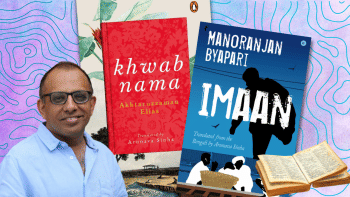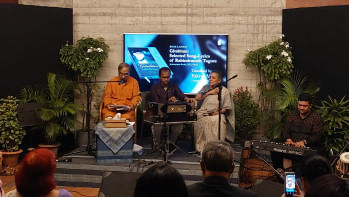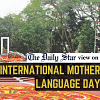Of translation

"Freud locates the beginning of analysis…in the legendary problematic of Moses' stutter; that is, in the necessity for translation, but a translation that can never quite correct a textual distortion it aggravates."
— Joseph Riddel, H.D.'s Scene of Writing - Poetry as (and) Analysis (1979)
The term "translation" in Middle English has its roots in the Latin word "translatio," in which "trans" signified "carrying" and "latio" denoted "across" or "over." This term, alongside its counterparts in Old French ("translacion") and in Anglo-Norman ("translacioum"), originally conveyed the act of transferring or transporting, meaning, from one language to another. Interestingly, its historical usage extended beyond linguistic transference, encompassing a practice that involved relocating a saint's deceased body, bones, or relics from their original burial sites to a different location. This broader understanding of "translation" persisted until around the 12th century. The dual connotations of linguistic and physical transfer underscored the rich historical and semantic evolution of the term in the context of Middle English.
The shifting nuances of estrangement, de-familiarisation, de-territoriality, mobility, and transit are integral to translation. Although "translation" is currently used interchangeably with "interpretation," the agency of its appellation was subtended by the structure of "interpretation" for many years until it took off on a resurgence in the early modern era, extending the scale and scope of the dialogic interaction between interpretation and translation. The word "hermeneus" was etymologised in ancient Greek from the root word "herma" (or, a heap of stones), as well as Hermes, the Greek deity and messenger of gods, to define an interpreter/translator of hieratic rites and liturgies; which, by extension included a deal-maker, go-between, marriage broker, and mediator, to name a few. The prevalence of "hermeneus" in Egypt, Greece, and Rome provides a testament to the pervasive use of translation qua interpretation in preliterate as well as literate cultures. Hermeneutics, or the branch of knowledge that deals with the interpretation of biblical and other literary and philosophical texts, captures the essence of translation in its broadest possible sense.
Needless to say, the ambit of translation spans adaptation, imitation, interpretation, interpellation, recreation, reconstruction, rendering, transformation, transliteration, transposition, transplantation (none of which are used synonymously), and beyond. Its theory and practice, regardless of how fraught the relationship between the two continues to be, encompasses close reading, dialogism, exegesis, and intertextual/intercultural/intersemiotic immersion praxis/ process, signalling quantum-like entanglements that crosscut a myriad of organising principles. Despite the semblance of being loaded with a whole gamut of signifiers, translation, both as process and product, remains woefully under-theorised illustrating what Ricoeur (2004) has already forewarned: "The practice of translation remains a risky operation which is always in search of its theory" (p. 33).
Simonetti (2022) argues that "if a translation is both an encounter between languages and a confrontation between cultures, it involves at the same time going out of oneself, finding oneself in the space of difference and experiencing the reality of others" (p. 284). To shed more light on this conundrum, Ricoeur introduced the illusion or simulacrum of a third, nonexistent archei text, analogous to the third man in Plato's Parmenides, through which both the source language and the target language could have been dovetailed/matched in a good/ideal translation hypothetically to celebrate the tour de force of capturing the invariant signification of intertextuality of two different languages. In the absence of any such semantic original/prototype as a frame of reference, he placed the onus of private retranslations on the critical reading of the competent/capable polyglots or bilingual readers, who would be equally confronted "with the same paradox of equivalence without adequacy" (Ricoeur, 2004. p. 7). It extends the "legendary metaphor of Moses's stutter" that Riddell alludes to. Ricoeur's point that the interminable retranslations of the great classics of the global culture were inspired by the dissatisfaction over the existing translations was premised on "the mourning (over the loss) for the absolute translation that produces the happiness (despite, if not because of, the ineluctable lack of homeostasis, I suppose) associated with translating."
Simonetti (2022) argues that "if a translation is both an encounter between languages and a confrontation between cultures, it involves at the same time going out of oneself, finding oneself in the space of difference and experiencing the reality of others."
Ricoeur squares with, if not finesse, the difference between "adequacy and equivalence," by emphasising "equivalence without adequacy," and/or "correspondence without adequacy," albeit averting an infinite regress, to accomplish what he coined as "linguistic hospitality." To expand on what Benjamin had suggested regarding the "Translator's Task," Ricoeur explored this win-some-lose-some endeavour by reconciling Freud's psychotherapeutic "work of remembering," associated with salvaging, or mimesis, and the "work of mourning," related to the experience of loss. The work of remembering is likened to the act of parturition, or childbirth, which speaks to the bipolarity between the nervousness of the mother tongue over preserving its identity/sanctity and the reader's resistance against the inroads of translation. The resistance the translator encounters results mostly from the question of untranslatability, which is sustained by the pressing concern that "the original will not be duplicated by another original" (Ricoeur 2004). The phantasy of perfect translation eventually took over by jettisoning the trepidation that any translation, as duplication (by definition) would always already fall short of the original.
The challenge of untranslatability is something that the translator has to contend with throughout the process of the enterprise, "making the translation a drama, and the wish for translation a wager." The end game of any ideal translation for Ricoeur is "linguistic hospitality," in which "the pleasure of dwelling in the other's language is balanced by the pleasure of receiving the foreign word at home, in one's own welcoming house" (p. 10). It reflects the primacy of "correspondence without adequacy" by foregoing "the illusion of a total translation which would provide a perfect replica of the original" (Kearney, 2004, p. xvii). This exegesis of translation resonates with Ricoeur's hermeneutics of the self, dubbed "oneself as another," which debunks the transcendental ego/signified of Cartesian Cogito by meandering through the thickets of solicitude before (re)inventing selfhood, no longer interchangeable with sameness. While "linguistic hospitality," true to its name, embraces diversity in terms of a hospitable relationship between one language and its implicit/explicit otherness, its mirror image "deconstructive hospitality" unsettles any such semblance of homeostasis by pointing at an irredeemably mired unequal power relationship.
Translation aspires to achieve anything but equifinality analogous to the blurring of an array of covert and overt boundaries approximating the Tower of Babel, a metaphor for a perfect paradisiacal language subtending the plurality of languages, as Ricoeur posits, to signal how this near prelapsarian condition always precedes the fall represented by translation, despite serving as the utopic conduit for translational exchanges among diverse languages, while its foil, a radical heterogeneity of languages, renders translation theoretically impossible. Refuting the received exegesis of this myth, Simonetti aptly observed, "Babel could be interpreted not so much as a catastrophe, caused by a God who is jealous of humanity's success, but rather as a description—without any form of condemnation—of the potential of languages…(and) an opportunity for thought" (p. 293). In a world relentlessly riven by the "matrix of domination," "masks of conquest," optics of phenotype, and a corpus of oppressive discursive formations and praxes, exacerbated by multiple intersectionalities, hyphenations, imbricated identities, otherness, paradigms, polarities, and subject positions foregrounding the geographies of inequality, inequity, and subalternity, among other incommensurability, translation is caught up in a perpetual crossing open to being "more sinned against than sinning." Moses' stutter, a metaphor for translation, as the epigram suggests, embraces increasing entropy and illuminates an elusive exegesis unintended to remedy "a textual distortion it (only) aggravates," even as it integrates mimesis and mourning to register a trade-off, contrary to what Ricoeur so cogently posits.
The end game of any ideal translation for Ricoeur is "linguistic hospitality," in which "the pleasure of dwelling in the other's language is balanced by the pleasure of receiving the foreign word at home, in one's own welcoming house."
Intriguingly, such a double bind consistently fails to become a permanent stranglehold for translation. As an evidence-informed praxis, in which a largely animated but unsettled enterprise is informed, if not stymied, by a host of incipient and evolving discursive formations, translation endlessly seeks to mimic the original by tapping into the associations, boundaries, cadences, colours, contours, denotations, connotations, sights, shades, sounds, and tropes constituting the "web of interrelationships" undergirding the specificity that distinguishes as well as the universality (if not the "universal grammar") that bonds and bridges the cultures and worldviews of both the source language and the target/receiving language. It amounts to shooting two (at least) moving targets all at the same time. Rabassa (1989) was on point to articulate, "Translation is a disturbing craft because there is precious little certainty about what we are doing, which makes it difficult in this age of fervent belief and ideology, this age of greed and screed" (p. 12). In such an enduring "labor of Sisyphus" (Rabassa, 1989), "the translation is never finished" (p. 7). Venuti (1995) contends that the most formidable predicament for the translator is the "perilous balance," between untranslatability and translatability. In this process, translation may tilt in favour of "foreignization" against "domestication" or vice versa. The terms were coined by Venuti (1995), under the influence of Schleiermacher, who postulated that translation moved in the direction of either the foreign author or the domestic reader, leaving the domestic reader, in the first instance, or the foreign author, in its variant, amply adrift. Since "foreignization," by definition, elevates the strangeness of the foreign text privileging its hegemony, the domestic reader in the target language as well as the target minority language and culture are rendered subservient. Tymoczko (1999) recommends upholding the domesticating principle to resist such a foreignizing strategy.
The intractable nonequivalence between the original language and the receiving/target language exacerbated by the untranslatability of the original language, contributes to the "translator's dilemma of choosing between fidelity and betrayal, or equivalence and inadequacy" (Ricoeur, 2004). Derrida (2001) describes the plight of the translator as "beautiful and terrifying" in one breath resulting in inevitably "insolvent duty and debt." Although Ricoeur sought to resolve the issue of "equivalence without identity" by replacing the binary of "translatable and untranslatable" with that of "faithful and unfaithful," Derrida argues that the most "relevant" translation is a trade-off, if not a double bind, between "nothing is translatable" and "nothing is untranslatable" (or "everything is translatable"), between "absolute relevance, the most appropriate, adequate, univocal transparency and the most aberrant and opaque irrelevance" (p. 6), regardless of how unintelligible it sounds. For practical purposes, untranslatability and translatability are regarded as mutually complementary rather than exclusive categories in that "their structural interdependence allows for meaning and at the same time prevents both total untranslatability and total translatability" (Davis, 2011, p. 75). Salman Rushdie has astutely put, "Having been borne across the world, we are translated men. It is normally supposed that something always gets lost in translation; I cling, obstinately, to the notion that something can also be gained."
Despite being an unlikely arbiter of elusive origin, translation painstakingly seeks to (re)trace the pathways of our irredeemable fall without having to forfeit many serendipitously fulfilling returns that entail mimicry, mimesis, and mourning.
This is a sequel to the article 'The Question of Translation' published in The Daily Star on September 30, 2023.
Faridul Alam teaches at the City University of New York.
Views expressed in this article are the author's own.
Follow The Daily Star Opinion on Facebook for the latest opinions, commentaries and analyses by experts and professionals. To contribute your article or letter to The Daily Star Opinion, see our guidelines for submission.

 For all latest news, follow The Daily Star's Google News channel.
For all latest news, follow The Daily Star's Google News channel. 











Comments